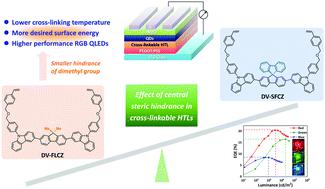当前位置:
X-MOL 学术
›
Mater. Chem. Front.
›
论文详情
Our official English website, www.x-mol.net, welcomes your
feedback! (Note: you will need to create a separate account there.)
Optimizing the central steric hindrance of cross-linkable hole transport materials for achieving highly efficient RGB QLEDs
Materials Chemistry Frontiers ( IF 6.0 ) Pub Date : 2020-09-18 , DOI: 10.1039/d0qm00591f Wenchao Zhao 1, 2, 3, 4, 5 , Liming Xie 5, 6, 7, 8, 9 , Yuan-Qiu-Qiang Yi 5, 6, 7, 8, 9 , Xiaolian Chen 5, 6, 7, 8, 9 , Jianfeng Hu 1, 2, 3, 4 , Wenming Su 5, 6, 7, 8, 9 , Zheng Cui 5, 6, 7, 8, 9
Materials Chemistry Frontiers ( IF 6.0 ) Pub Date : 2020-09-18 , DOI: 10.1039/d0qm00591f Wenchao Zhao 1, 2, 3, 4, 5 , Liming Xie 5, 6, 7, 8, 9 , Yuan-Qiu-Qiang Yi 5, 6, 7, 8, 9 , Xiaolian Chen 5, 6, 7, 8, 9 , Jianfeng Hu 1, 2, 3, 4 , Wenming Su 5, 6, 7, 8, 9 , Zheng Cui 5, 6, 7, 8, 9
Affiliation

|
Cross-linking strategies of hole transport materials (HTMs) have been widely investigated and used in various optoelectronic devices, mainly owing to their excellent solvent resistance and thermal stability. More importantly, the energy level and charge mobility of cross-linkable HTMs can be fine-tuned through precise molecular design, which offers great opportunities to explore and screen efficient HTMs. Currently, the investigations of cross-linkable HTMs are limited in the research of quantum dot light emitting diodes (QLEDs), which could not realize the full advantages of the superior emissive properties of QDs and benefits of solution-processing fabrication techniques. Thus, we synthesized two cross-linkable materials DV-SFCZ and DV-FLCZ with different center cores to explore the influence of the central steric hindrance on the properties. With a smaller central steric hindrance, the cross-linking temperature of DV-FLCZ is 75 °C lower than that of DV-SFCZ, and the cross-linking time is shortened by 2/3 times, which is of great significance in future practical application. DV-FLCZ shows a better hole transport property, which favors hole injection into the QD layer. Notably, red, green and blue QLEDs with DV-FLCZ as the HTM achieved a maximum EQE of 20.5%, 16.6% and 8.5%, respectively, which are much better than the devices based on DV-SFCZ as the HTM. To the best of our knowledge, the results represent the highest EQE values of QLED performance using cross-linkable materials alone as hole transport layers.
中文翻译:

优化可交联空穴传输材料的中心位阻,以实现高效的RGB QLED
空穴传输材料(HTM)的交联策略已被广泛研究并用于各种光电设备中,这主要是由于其优异的耐溶剂性和热稳定性。更重要的是,可以通过精确的分子设计对可交联HTM的能级和电荷迁移率进行微调,这为探索和筛选高效HTM提供了巨大的机会。目前,可交联HTM的研究仅限于量子点发光二极管(QLED)的研究,无法充分发挥QD优异的发射性能和溶液加工制造技术的优势。因此,我们合成了两种可交联材料DV-SFCZ和DV-FLCZ以不同的中心核心探索中心位阻对性能的影响。用较小的中央的空间位阻,的交联温度DV-FLCZ为75℃降低比的DV-SFCZ,和交联时间由2/3倍缩短,这是很有意义的将来会实际应用。DV-FLCZ具有更好的空穴传输性能,有利于将空穴注入QD层。值得注意的是,以DV-FLCZ作为HTM的红色,绿色和蓝色QLED的最大EQE分别达到20.5%,16.6%和8.5%,这比基于DV-SFCZ的设备要好得多。作为HTM。据我们所知,仅使用可交联材料作为空穴传输层,结果代表了QLED性能的最高EQE值。
更新日期:2020-10-07
中文翻译:

优化可交联空穴传输材料的中心位阻,以实现高效的RGB QLED
空穴传输材料(HTM)的交联策略已被广泛研究并用于各种光电设备中,这主要是由于其优异的耐溶剂性和热稳定性。更重要的是,可以通过精确的分子设计对可交联HTM的能级和电荷迁移率进行微调,这为探索和筛选高效HTM提供了巨大的机会。目前,可交联HTM的研究仅限于量子点发光二极管(QLED)的研究,无法充分发挥QD优异的发射性能和溶液加工制造技术的优势。因此,我们合成了两种可交联材料DV-SFCZ和DV-FLCZ以不同的中心核心探索中心位阻对性能的影响。用较小的中央的空间位阻,的交联温度DV-FLCZ为75℃降低比的DV-SFCZ,和交联时间由2/3倍缩短,这是很有意义的将来会实际应用。DV-FLCZ具有更好的空穴传输性能,有利于将空穴注入QD层。值得注意的是,以DV-FLCZ作为HTM的红色,绿色和蓝色QLED的最大EQE分别达到20.5%,16.6%和8.5%,这比基于DV-SFCZ的设备要好得多。作为HTM。据我们所知,仅使用可交联材料作为空穴传输层,结果代表了QLED性能的最高EQE值。











































 京公网安备 11010802027423号
京公网安备 11010802027423号